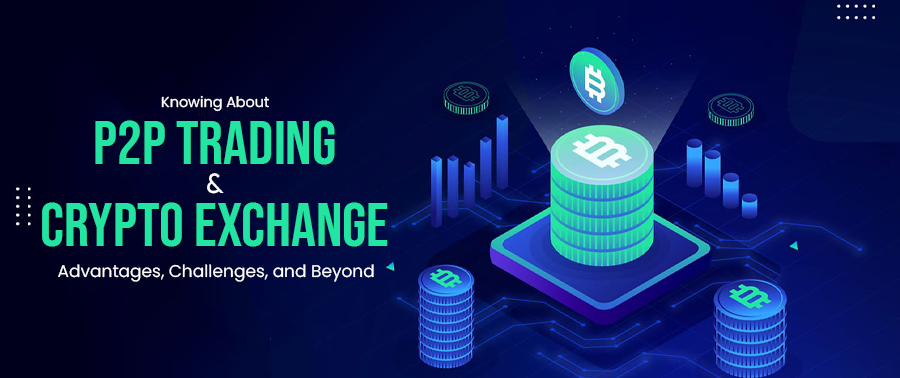Cryptocurrency is the most discussed topic and the most valuable digital asset in today’s virtual economy. This currency has overcome numerous challenges to achieve its current prominence. The user base for these digital assets has steadily expanded, driven by the distinct advantages they offer over alternative forms of currency. This increasing demand for cryptocurrency exchange platforms, especially those utilizing the Peer-To-Peer (P2P) method, underscores the growing significance of these virtual currencies in the contemporary landscape. In this guide, we will delve into the fundamentals of P2P exchanges, exploring their benefits, differences from centralized counterparts, and how they function. This comprehensive overview aims to equip you with the knowledge to effectively navigate and scale your crypto trading endeavors.
Peer-to-peer (P2P) technology, which traces its roots back to the music-sharing platforms of the 90s, has undergone a transformative journey. Initially popularized by services like Napster, P2P has evolved into a cornerstone of the financial world, notably within the cryptocurrency domain.
Understanding the Essence of P2P Trading:
At its core, P2P denotes a direct, decentralized exchange of goods or services between individuals, sidestepping the need for intermediaries. P2P networks, comprising computers acting as both clients and servers, facilitate these interactions. In the context of cryptocurrency trading, P2P signifies a departure from traditional methods, offering users the autonomy to set their buy or sell prices and locate counterparts without the involvement of centralized entities.
P2P Crypto Exchange
P2P crypto exchanges represent a revolutionary shift in the landscape of digital asset trading, operating on a decentralized framework that sets them apart from traditional counterparts. These platforms empower users by eliminating intermediaries, allowing buyers to engage in direct transactions with each other without the oversight of a central authority. Much like the foundational principles of popular cryptocurrencies such as Bitcoin and Ethereum, P2P exchanges operate on a decentralized ethos, with no single entity exerting control over the platform.
The decentralized nature of P2P crypto exchanges leverages blockchain technology to ensure secure and transparent transactions. Every trade occurs across a distributed and secure blockchain network, where miners and anonymous individuals, validate and approve transactions. This decentralized validation process not only ensures the integrity of the trades but also upholds the autonomy of users. By removing the need for a central authority, P2P exchanges provide users with unlimited control over their trades, fostering a peer-to-peer ecosystem that is both resilient and self-sustaining. In essence, P2P crypto exchanges embody the spirit of blockchain technology, promoting trust, transparency, and user empowerment in the dynamic world of digital asset trading.
Distinguishing P2P Crypto Trading from Traditional Methods
In contrast to conventional payment systems like UPI, P2P crypto trading empowers users to dictate their transaction terms. This autonomy eliminates charges and commissions, mitigating the risk of fund loss due to external errors. While a decentralized mediator, often in the form of a cryptocurrency exchange, oversees these transactions, the absence of traditional intermediaries distinguishes P2P trading as a unique and efficient mechanism.
The P2P Trading Process on Crypto Exchanges
Crypto exchanges employ smart contracts to streamline and automate P2P trading. These contracts, self-executing when predefined conditions are met, ensure the seamless transfer of funds. Parties involved in a P2P trade enter into a decentralized agreement, and the smart contract oversees the transaction, transferring ownership upon the fulfillment of specified conditions. P2P functionality is utilized in various capacities on exchanges, including crypto-to-crypto exchanges, direct fiat-to-crypto purchases, and even file sharing.
P2P Trading Strategies
The P2P crypto trading journey necessitates strategic approaches to optimize outcomes. Two prominent strategies include:
Arbitrage Trading:
Capitalizing on price disparities between different crypto exchanges, arbitrage trading leverages short-term variations driven by factors such as market volatility, regulatory fluctuations, or liquidity issues. Traders seek to exploit these differences for profit.Establishing a High-Demand Payment Method:
In regions where fiat payment options are limited on P2P exchanges, savvy traders can set up platforms enabling users to purchase crypto directly with fiat. This approach allows sellers to impose premiums or levy commissions, presenting an opportunity for lucrative revenue generation at scale.
Advantages of P2P Crypto Trading:
P2P crypto trading boasts numerous advantages, making it an increasingly attractive option for market participants:
Global Accessibility:
One of the primary merits of P2P trading is its global accessibility. Participants are not bound by geographical constraints, enabling seamless engagement with users worldwide, irrespective of currency.Resistance to Government Restrictions:
The decentralized nature of P2P transactions makes it challenging for governments to regulate or restrict such transactions. This freedom allows users to engage in transactions without imposed limitations.Elimination of Commissions and Fees:
P2P transactions circumvent traditional commissions and trading fees associated with centralized platforms, maximizing returns for participants.Flexible Payment Methods:
The availability of multiple payment methods provides users with the flexibility to choose options with minimal overhead costs, ultimately enhancing profit margins.
While P2P crypto trading offers a host of advantages, it is not free from challenges:
Fraud Risks:
The absence of a centralized intermediary raises concerns about the authenticity of transaction participants, making fraudulent transactions a potential risk. Participants must exercise caution and implement security measures to mitigate this threat.Delayed Transactions:
The absence of a mediating third party can lead to longer transaction times. Matching optimal pairs of buyers and sellers may take time, requiring participants to exercise patience throughout the process.
In the contemporary financial scenario, P2P technology has transcended its origins, finding applications beyond music-sharing platforms. From the development of open-source software to file sharing and, most notably, cryptocurrency trading, P2P has become a dynamic force. As the fintech space continues to evolve, P2P is poised to play an increasingly pivotal role. Equipping oneself with a nuanced understanding of P2P crypto trading is paramount, offering individuals the knowledge needed to navigate this decentralized terrain effectively and capitalize on the opportunities it presents.





Top comments (0)